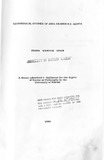| dc.contributor.author | Dindi, Edwin W | |
| dc.date.accessioned | 2013-05-10T09:12:08Z | |
| dc.date.available | 2013-05-10T09:12:08Z | |
| dc.date.issued | 1992 | |
| dc.identifier.citation | Ph.D Thesis | en |
| dc.identifier.uri | http://erepository.uonbi.ac.ke:8080/xmlui/handle/123456789/21189 | |
| dc.description | Ph.D Thesis | en |
| dc.description.abstract | Anza Graben is situated in the north and northeastern Kenya. It is about
120km wide and approximately 600 km long. The area of the present
study is located mainly in NE Kenya and constitutes a strike length of
about 300 km. The graben is almost entirely sediment filled and is
estimated to be of Cretaceous age. It is characterized by a prominent
negative Bouguer anomaly reaching -40 mGal.
Several studies were made in an effort to determine its subsurface
structure. These involved interpretation of a number of seismic reflection
profiles, 3D interactive gravity modelling using fixed density contrasts
between the sediment in fill and the basement, and the analysis by filtering
and modelling of the aeromagnetic data over the graben. A crustal
modelling of refraction data along the western shoulder of the Anza graben
using 2D ray tracing was also performed.
Two major basins are recognizable from the results of the studies, namely
the southern basin which has a northeasterly dip and the northern basin
having a southwesterly one. This alternating asymmetry is also indicated
for an adjoining smaller basin located to the west of the graben. The
density contrast used for the final gravity model is -300 kg/m3 which
indicates a maximum sediment thickness of about 8 km. The modelling of
aeromagnetic data however favour a maximum thickness of at least
10km. A 2D refraction crustal P wave model of the western shoulder
indicates that the crust thins northwestwards with the Moho depth
decreasing from 35 km under Chanler's Falls to approximately 29 km
under the southeastern shores of Lake Turkana. The abrupt shallowing of
the Moho in the Lake Turkana area is attributed to the effects of the
Kenya Rift Valley. However the gentle variation in the Moho depth along
the remaining section of the shoulder of Anza Graben appears to depict a
regional phenomenon also attributable to the formation of the Kenya Rift
Valley.It is proposed from the study that sections of the graben shoulder
are underlain by slightly denser rocks and that the crustal thinning
associated with Anza Graben is not Significant. | en |
| dc.description.sponsorship | University of Nairobi | en |
| dc.language.iso | en | en |
| dc.title | Geophysical studies of Anza Graben N.E. Kenya | en |
| dc.type | Thesis | en |
| local.publisher | Department of Geology, University of Nairobi | en |

